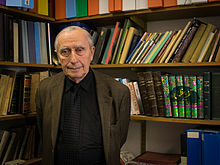Qissat Shakarwati Farmad
Qissat Shakarwati Farmad (alternatively Qissat Shakruti Firmad[1]) ("Tale of the Great Chera Ruler") is an Arabic manuscript of anonymous authorship, apparently written in Malabar, in British Library (India Office Records, MS. Islamic 2807d, fols. 81a-104a).[1][2] It is argued that the Qissat is the oldest, most detailed, and comprehensive recorded version of the famous Cheraman Perumal legend (of southern India).[3] The later versions of the legend are incorporated by Zayn al-Din in Tuhfat al-Mujahidin (16th century CE)[2] and in Ta'rikh-i Firishta (Persian, 17th century CE). Varied versions of the legend can also be seen a number of medieval Kerala literary sources (such as Keralolpatti) and Portuguese chronicles.[3] A Telugu version of the legend is also mentioned by some scholars.[4]
As per scholar Y. Friedmann, the version famously narrated by Zayn al-Din was directly derived from the Qissat.[2]
The legend fundamentally deals with the introduction of Islam in Malabar. Almost all of the sources tell the story the Hindu ruler of Kerala, titled Cheraman Perumal, who converted to Islam, divided his kingdom among his chiefs, sailed for Arabia with the intent of performing the hajj and died on his return journey.[2]
Shakarwati Farmad is an Arabic version of the medieval Indian royal title "Chakravarti Cheraman Perumal". The Chera king is also referred within the text as "al-Sultan Shakrawati".[3] Unlike some of the other versions of the legend, large portions of the Qissat takes place after the king's death on Arabian coast.[3]
First mosques of Malabar according to the Qissat[5]
According to the Qissat, the first mosque was built by Malik ibn Dinar in Kodungallur, while the rest of the mosques were founded by Malik ibn Habib.[3]

| Location | Qadi |
|---|---|
| Kalankallur (Kodungallur) | Muhammad ibn Malik |
| Kulam (Kollam) | Hasan ibn Malik |
| Hili (Madayi) | 'Abd al-Rahman ibn Malik |
| Fakanur/Makanur (Barkur) | Ibrahim ibn Malik |
| Manjalur (Mangalore) | Musa ibn Malik |
| Kanjarkut (?Kasaragod) | Malik ibn Muhammad |
| Jurfatan/Jirfatan (Cannanore) | Shahab al-Din ibn 'Umar ibn Muhammad ibn Malik |
| Darmaftan (Dharmadam) | Hussayn ibn Muhammad ibn Malik al-Madani |
| Fandarinah (Panthalayani) | Sa'd al-Din ibn Malik al-Madani |
| Shaliyat (Chaliyam) | Zayn al-Din ibn Muhammad ibn Malik al-Madani |
References
- ^ a b O. Loth, Arabic Manuscripts in the Library of the India Office (London: Secretary of State of India, 1877), no. 1044.
- ^ a b c d Y. Friedmann, "Qissat Shakarwati Farmad: A Tradition Concerning the Introduction of Islam to Malabar", Israel Oriental Studies 5 (1975), 239-241.
- ^ a b c d e Prange, Sebastian R. Monsoon Islam: Trade and Faith on the Medieval Malabar Coast. Cambridge University Press, 2018. 95-98.
- ^ H. H. Wilson, Mackenzie Collection. A descriptive catalogue of the Oriental manuscripts and other articles illustrative of the literature, history, statistics and antiquities of the south of India (Calcutta, 1828), II, appendix, p. XCV.
- ^ Prange, Sebastian R. Monsoon Islam: Trade and Faith on the Medieval Malabar Coast. Cambridge University Press, 2018. 98.
